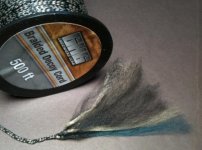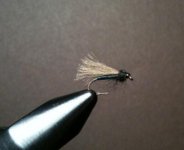dc410
Well-known member
Last weekend I was flintlock hunting with my son. After busting through about a 1/4 mile of briars in an attempt to get some deer up and moving for him, I sat down on a log for a short breather. As I was sitting there I noticed the cord that I had my touchhole cleaner tied to the trigger guard of my flintlock was severly frayed at the end. As I looked at it closer I noticed that this cord was made up of green, tan and black material braided together and it even has a bit of a sheen to it. I bought this material a few years ago at Cabelas, it is called Braided Decoy Cord and it has a very small diameter and it very strong as its primary purpose is obviously to anchor duck decoys. I was looking at the frayed material and teasing it out even more and suddenly I thought that I could probably tie a pretty decent Caddis pattern out of this stuff.
So upon returning home I took this frayed piece of decoy cord to my vise and tied a caddis pattern totally out of the material used to make the decoy cord. I am not sure how it will react when fished, but whether it is greased to ride on top or fished in the film or even under the surface I think it will be a productive pattern. I basically tied this pattern with the Tulpehocken in mind when the green caddis start popping this spring. Here is a photo of my decoy caddis tied on a size 16 dry fly hook.
So upon returning home I took this frayed piece of decoy cord to my vise and tied a caddis pattern totally out of the material used to make the decoy cord. I am not sure how it will react when fished, but whether it is greased to ride on top or fished in the film or even under the surface I think it will be a productive pattern. I basically tied this pattern with the Tulpehocken in mind when the green caddis start popping this spring. Here is a photo of my decoy caddis tied on a size 16 dry fly hook.






